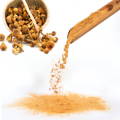Agaricus

Latin Name
Total Polysaccharides %
Beta Glucans %
Starch
Mycilium or Fruiting Bodies?
Substrate
Extract Ratio
Sustainably Grown
Amount per Serving
What is Agaricus?
For many years, mushrooms have been consumed as a fermenting ingredient in the manufacturing process of food and drinks, nutrient supplement in human diets, and eventually as a medication for various human diseases. Agaricus blazei, a curative mushroom growing naturally in the coastal Piedade rain forest region in the State of Sao Paulo in Brazil, is often known as Cogumelo do Sol in Brazil, Himematsutake in Japan, and Ji Song Rong in China [1]. In 1965, Agaricus blazei was sent to Japan for examination in medicine because it became the focus of extensive medical studies with outstanding immunomodulation and anti-tumor activities. It was consumed traditionally as a food ingredient and was believed to be effective in treating a board range of diseases.
Agaricus blazei’s fruiting body is high in β-Glucans, and the pharmacological impact and was linked to the immunomodulatory activity of this polysaccharide, particularly through stimulation of the immune system. In general, the fruiting body’s composition is 87% water, 45% carbohydrates, 8% fiber, and 45% crude protein. Over and above that, the significant minerals extracted form Agaricus blazei are, calcium, potassium, magnesium, iron, zinc, phosphorus, and sodium [2].
Investigations for clinical uses of Agaricus blazei found that it can be used for treating diabetes type 2, inflammatory bowel diseases including ulcerative colitis and crohn’s disease, different types of cancer as leukemia, prostate cancer, ovarian cancer and lung cancer, and finally helps in reducing the inflammations that can leads to chronic hepatitis infections.
